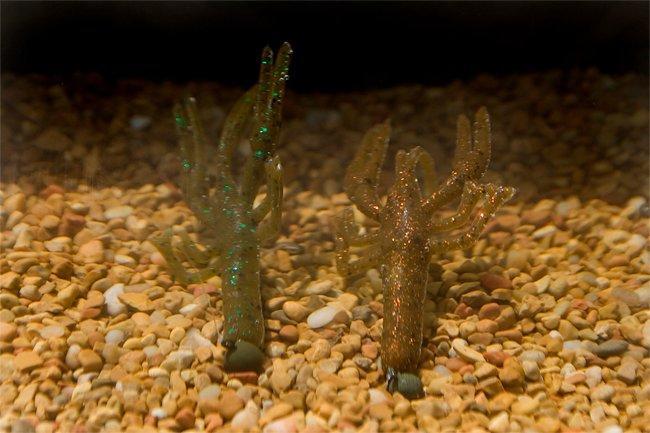We all have our favorite colors. Especially when it comes to soft plastics. Some guys will tell you any color is fine as long as it’s green pumpkin. But even green pumpkin has been spruced up by manufacturers. Now you can get green pumpkin with blue, red, green, purple, orange, black, gold, and other flakes in it.
Zoom is one manufacturer that has done a lot with flakes in common plastic base colors over the last 12-18 months. They recently released green pumpkin orange and watermelon orange baits. We’ve been testing several of the bait shapes like the Brush Hog, Speed Craw and Trick Worm with very good success in these new colors.
Now even something as simple as green pumpkin, however, might seem complicated to anglers. But really we’ve all seen days where the guy in the front of the boat is throwing a color just slightly different than the guy in the back. The guy in the front catches bass routinely while the back seat guy is catching a few here and there. The fact is some days, and even more routinely some seasons, slight variations in color matter.
It happened to us too. We were prepping for a tournament recently and figured out the fish were in certain places around shallow cover. But what we also figured out was that Watermelon Candy is not the same as Watermelon Red. Green pumpkin green flake is not the same as green pumpkin orange flake.
For some reason, and this seems to be the case on a lot of fisheries across the nation, orange and red flakes in baits become especially important around the spawn. Before, during and after, we’ve seen time and time again where a natural hue mixed with a brighter flake really triggers the fish to bite when they have mating on the mind.
My partner flipped on the front deck with me shoulder to shoulder, and I was literally getting three to five bites for every one of his. This went on for hours. Long enough that we decided we definitely had found a winning color.
So it made us look at similar baits in the water with different flakes in them. The flake actually appears to change the overall mask of the whole bait. Our green pumpkin orange appeared more earthy and almost like a creature that favored clay banks. While a green pumpkin with green flake appeared more like it would live around weedy dark bottom areas. I think a lot of the time that is exactly why a certain flake triggers the fish more than just the base color of the plastic.
It can also be attributed to prey changing colors at different times of the year. Perhaps the crawfish molt and there are very small details that change dramatically. Those small details could be the trigger that the fish key on to know the bait you’re presenting is what they are after. Several species of bluegill turn different colors around their spawning seasons but a lot of it is the details surrounding their base colors flare bright colors.
Same is said for the bass. Ever catch a smallmouth or spotted bass off a bed and remark about how red their eyes had turned? I think sometimes a small detail in a bait is what a bass triggers on more than anything. It’s like if its missing that one small detail, it knows something isn’t right. They make split second decisions based on impulses, glimpses and what they see with their high flicker rate of vision. A small glimmer of flake could be the key.
I saw someone talking about creating UV flakes to put in plastics for deep water fishing. I think that would be a terrific idea. It could be that small detail that is the flicker vision trigger for the bass without making the whole bait a glow in the dark nuclear worm.
Before this latest encounter with the bass on my home lake, I’d considered flake in plastics arbitrarily. Now I will certainly pay more attention.
Check out what Zoom is doing with flakes on some of their baits here.











